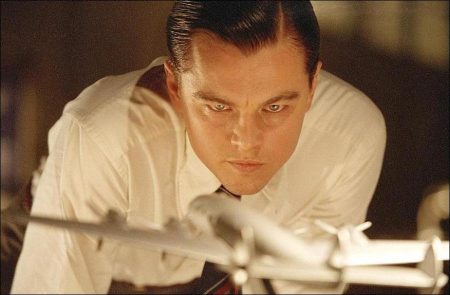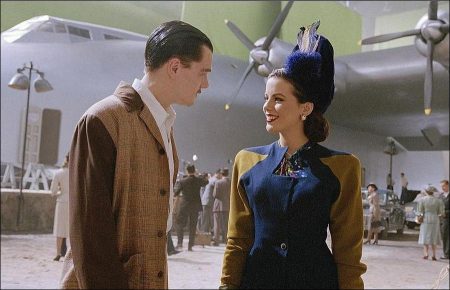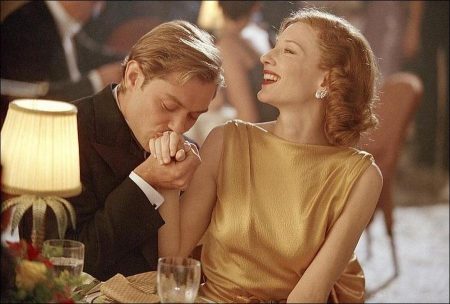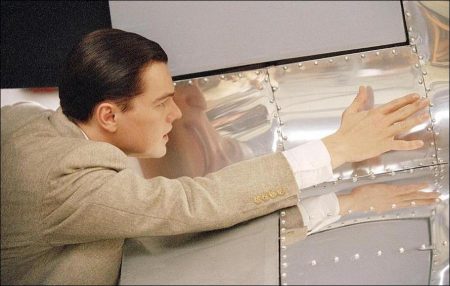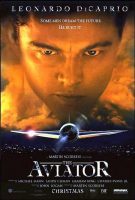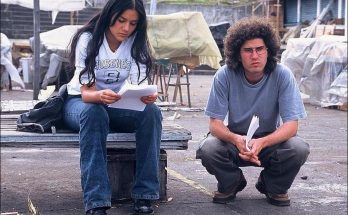Tagline: Some men dream the future. He built it.
Biopic of billionaire Howard Hughes, starting with his early filmmaking years as owner of RKO studios but mostly focusing on his role in designing and promoting new aircraft. Hughes was a risk-taker spending several fortunes on designing experimental aircraft and eventually founding TWA as a rival to Pan AM airlines owned by his great rival Juan Trippe.
When Trippe’s politico Senator Ralph Owen Brewster accuses Hughes of being a war profiteer, it’s Hughes who gains the upper hand. Hughes also had many women in his life including a long relationship with actress Katharine Hepburn. From an early age however, Hughes was also germophobic and would have severe bouts of mental illness.
“The Aviator” looks at Hughes’ emotional life, and his love affairs with two Hollywood legends, elegant, Yankee-bred screen star Katharine Hepburn in the 1930s, and the sensual and luminous screen beauty of the 1940s, Ava Gardner. It also chronicles Hughes’ struggle with his physical disabilities and phobias, and with his increasingly erratic, obsessive-compulsive behavior that leads him ultimately to isolate himself from his associates and withdraw from the world.
The Aviator is a 2004 American epic biographical drama film directed by Martin Scorsese, written by John Logan. It stars Leonardo DiCaprio as Howard Hughes, Cate Blanchett as Katharine Hepburn and Kate Beckinsale as Ava Gardner. The supporting cast features Ian Holm, John C. Reilly, Alec Baldwin, Jude Law as Errol Flynn, Gwen Stefani as Jean Harlow, Kelli Garner as Faith Domergue, Willem Dafoe, Alan Alda, and Edward Herrmann.
Based on the 1993 non-fiction book Howard Hughes: The Secret Life by Charles Higham, the film depicts the life of Howard Hughes, an aviation pioneer and director of Hell’s Angels. The film portrays his life from 1927–1947 during which time Hughes became a successful film producer and an aviation magnate while simultaneously growing more unstable due to severe obsessive–compulsive disorder (OCD).
The Aviator was released in the United States on December 25, 2004. The film grossed $214 million at the box office. It was nominated for eleven Academy Awards, including Best Picture, Best Director, Best Original Screenplay, Best Actor in a Leading Role for DiCaprio, and Best Actor in a Supporting Role for Alda, winning five for Best Cinematography, Best Film Editing, Best Costume Design, Best Art Direction and Best Actress in a Supporting Role for Cate Blanchett.
Writing Howard Hughes
Though he is remembered today as the eccentric billionaire who became a mysterious recluse, few know the full story of the industrialist Howard Hughes – nor how Hughes, as a young man in love with risk, beauty and technology, became a towering figure who made bold leaps in business, aviation and movies, only to lose himself in a world of fear and paranoia.
This is the story that comes to the fore in Martin Scorsese’s The Aviator. The project originated with Leonardo DiCaprio who, after reading about the biography of Hughes at a young age, became passionate in his quest to make a film about this uniquely American life. DiCaprio was well aware that several big Hollywood stars had tried to no avail to make movies about Hughes before.
DiCaprio originally brought the idea to director Michael Mann, who in turn brought in screenwriter John Logan (“Gladiator”). DiCaprio and Mann decided to take a different approach. They wanted to focus on Hughes’ explosively creative and visionary youth rather than his descent into madness in later years. After Mann chose instead to produce the film, he and DiCaprio agreed on a short list of directors. Topping it was the director Mann and DiCaprio esteemed most, Martin Scorsese. He agreed to direct.
After Scorsese was on board, Graham King’s Initial Entertainment Group agreed to finance the movie and King became a producer along with Mann and his Forward Pass partner Sandy Climan. Once rights were secured from Forward Pass, King brought in Miramax followed by Warner Brothers to partner on domestic distribution.
King having worked with Scorsese as an executive producer and financier of Gangs of New York feels strongly that Scorsese’s love of movie history and filmmaking techniques mirrored the same qualities in Hughes in a wonderfully synergistic way – and that Scorsese brought his own sense of risk-taking and invention to making the film. “Marty is so terrific with detail and creating period realistically, and he has so much love and respect for the era of filmmaking during which Howard Hughes made his mark, he was clearly right for this story,” says King.
He continues: “Marty has certain things in common with the character of Howard Hughes in The Aviator in that he’s someone who’s very precise in what he wants, who can invent things, who loves the process of making movies. This was a chance for Marty to do something unlike anything he’s done before – a story set in Hollywood. It was such a pleasure to work by Marty’s side, everyday, on set.”
“Howard Hughes, The Aviator, performed feats of incredible bravery in his life, and I was drawn to the script,” Scorsese says. “Here was a Nineteenth Century-type figure who was a pioneer in two of the greatest phenomena of the Twentieth Century: aviation, with his innovative designs and speed records, and filmmaking, with such movies as ‘Hell’s Angels’ and ‘Scarface.’ Hughes was also a great showman, but his story is the story, ultimately, of greed, corruption and madness.”
“When I developed the screenplay with John Logan for over a year and half the earliest decision was to end the picture in 1947, with the first day of the rest of Howard’s life,” says Mann. “And that was because we decided the most interesting central conflict…the most personal… should be between Howard as a visionary, and his mental disease…including his awareness of it and all that it lost him in human terms, isolating him…”
Logan had been astonished by the sheer vastness of Hughes’ life. “There was so much in his story that fascinated me: American history and biography and the kind of large, complex characters that I love to write about,” he notes. “Also, I felt from the beginning that Leo was perfect casting for the role of Hughes, so I was very excited to write with him in mind.”
Logan spent an entire year researching Hughes’ life, reading every book, memoir and archival materials he could get his hands on – and coming away with an entirely fresh vision of Howard Hughes as less of a myth and more of a brilliant, yet flawed, human being. “It was a fascinating process of discovery,” he recalls. “I think most of us start out with a certain image of Hughes –and it’s usually the man at the end of his life, the crazy, deeply eccentric recluse in his hotel room with long fingernails and empty Kleenex boxes as shoes. But I found someone else altogether. I discovered Howard as a vibrant, young hero who was a driving force in both aviation and Hollywood at their most glamorous.”
He continues: “I started by reading all the standard biographies and then branched out into the other areas in which Hughes was concerned. I read about aeronautics and engineering and why Hughes’ innovations were such amazing achievements; I learned about the world of commercial aviation and the corporate battles between Pan Am and TWA; and I also read about the days of early Hollywood filmmaking when silent film gave way to sound, about the fights over the Hollywood production code, and about the lives of the many magnificent women with whom Hughes was romantically involved.”
When Logan at last started writing he decided to concentrate the time frame of the story between two major milestones in Hughes’ life: opening with the production of “Hell’s Angels” in the late 1920s, when Hughes was just barely an adult, and culminating with TWA’s emergence as a major international airline in the late 1940s. Between these two junctures of high achievement, Logan began to explore the torment and tumult at the center of Hughes’ character so as to provide a glimpse inside both his dreams and his demons.
As with any film biography, Logan had to make some dramatic allowances along the way in order to fit the story to the art form. “Covering twenty years of a man’s life in a couple of hours necessarily meant that I had to compress some events, combine characters and shift around chronology,” explains Logan, “but the aim was always to capture the man, if not everything that happened to him, as truly as possible.”
Adds Graham King: “Howard Hughes led such a tremendous life, but John Logan found a way to distill it down to the most compelling and entertaining parts of the story, between the daredevil stunts of ‘Hell’s Angels’ to the triumph of Hughes flying The Hercules. He shows many different elements of Howard’s reality that people don’t really know about, from the Senate hearings to his love affairs.”
Once Martin Scorsese came aboard, Logan was inspired to explore the story in even greater depth, delving into every aspect of the larger-than-life character’s internal makeup. Logan, Scorsese and DiCaprio worked together for months, fine-tuning the story in their own ways. “Martin Scorsese and Leonardo DiCaprio were the most exacting, supportive and willing of colleagues, and they challenged me to write the best script possible,” Logan says. “What was important to each of us was to maintain a honesty as we adapted the details of Hughes’s story. Marty and Leo are fanatical about the truth and were committed to understanding the character in the depth of his soul.”
He continues: “The structure of the story didn’t change so much, but it was more the approach to various scenes, the intensity of certain incidents. Marty brings an incredible visual panache to telling a story, and he has such an artistic feel for momentum, for keeping the action on track that he brought an enormous amount to the process. And Leo has a wonderful ear for period dialogue, for what seems appropriate to the character at any given moment. He was very creative about pitching story ideas and dialogue. Each of us is an alpha personality, and we all loved to talk about Howard Hughes, so it was like electricity shooting out of the room at every meeting.”
Although Hughes had affairs with a number of famous women, Logan also chose to narrow the story focus down to two of the most important in Hughes’ life. “We decided to focus first on his relationship with Katharine Hepburn, which is considered to be the most important relationship of his life, and secondly with Ava Gardner, who was a part of Howard’s life for two decades,” comments Logan.
Logan also explored some of Hughes’ medical maladies – his childhood loss of hearing that made him nearly deaf as well as the undiagnosed obsessive-compulsive disorder that combined with his deeply-rooted germ phobia to provoke some of his strange behavior. “Howard was acutely aware of his fragility,” Logan says, “He had a constant fear of going mad.”
“I think he felt the darkness out there pressing in on him and knew that one day he would lose the battle, as he did. But to me, the man’s self- knowledge is what makes him so interesting and poignant, a sad, lonely yet brilliant man–a tragic figure.”
Summarizes Martin Scorsese: “One of the most fascinating elements of the story of The Aviator is seeing this extraordinarily handsome and bright young man, so full of life, become a man who’s tortured by his own shortcomings.”
Adds Leonard DiCaprio: “Howard Hughes is probably one of the 20th century’s most iconic and mysterious figures – and in some ways the more you learn about him the more mysterious he becomes. There are so many facets to Howard that it makes him an endlessly fascinating character. Just when you think you have him figured out, there’s another layer to the story. He was a dreamer and a visionary, but the irony of it all is that even after all of his accomplishments – huge industrialist, pioneering aviator, big-time producer and director – at the end of the day he felt very much alone.”
The Aviator (2004)
Directed by: Martin Scorsese
Starring: Leonardo DiCaprio, Alan Alda, Alec Baldwin, Kate Beckinsale, Cate Blanchett, Danny Huston, Gwen Stefani, Alan Alda, Kelli Garner, Frances Conroy
Screenplay by: John Logan
Production Design by: Dante Ferretti
Cinematography by: Robert Richardson
Film Editing by: Thelma Schoonmaker
Costume Design by: Sandy Powell
Set Decoration by: Francesca Lo Schiavo
Art Direction by: Robert Guerra, Claude Paré, Luca Tranchino
Music by: Howard Shore
MPAA Rating: PG-13 for thematic elements, sexual content, nudity, language and crash sequence.
Distributed by: Miramax Films
Release Date: December 17, 2004
Visits: 46
